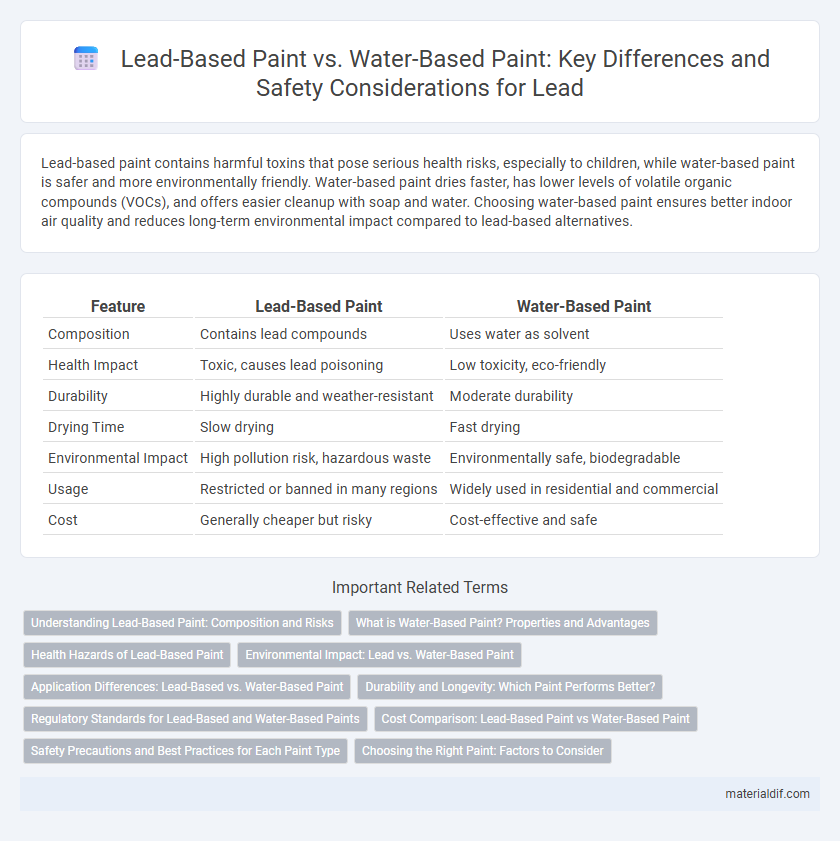Lead-based paint contains harmful toxins that pose serious health risks, especially to children, while water-based paint is safer and more environmentally friendly. Water-based paint dries faster, has lower levels of volatile organic compounds (VOCs), and offers easier cleanup with soap and water. Choosing water-based paint ensures better indoor air quality and reduces long-term environmental impact compared to lead-based alternatives.
Table of Comparison
| Feature | Lead-Based Paint | Water-Based Paint |
|---|---|---|
| Composition | Contains lead compounds | Uses water as solvent |
| Health Impact | Toxic, causes lead poisoning | Low toxicity, eco-friendly |
| Durability | Highly durable and weather-resistant | Moderate durability |
| Drying Time | Slow drying | Fast drying |
| Environmental Impact | High pollution risk, hazardous waste | Environmentally safe, biodegradable |
| Usage | Restricted or banned in many regions | Widely used in residential and commercial |
| Cost | Generally cheaper but risky | Cost-effective and safe |
Understanding Lead-Based Paint: Composition and Risks
Lead-based paint contains lead compounds such as lead carbonate and lead sulfate, which provide durability and moisture resistance but pose significant health risks, especially to children exposed to lead dust or chips. Its composition makes it highly toxic, leading to lead poisoning, neurological damage, and developmental delays upon ingestion or inhalation. Proper identification and safe removal of lead-based paint are critical to preventing hazardous exposure in older buildings.
What is Water-Based Paint? Properties and Advantages
Water-based paint, often called latex paint, consists of pigments suspended in a water-soluble binder that dries faster and emits fewer volatile organic compounds (VOCs) than lead-based paint. Its properties include quick drying time, easy cleanup with water, and lower toxicity, making it safer for indoor environments and reducing health risks associated with lead poisoning. Advantages of water-based paint include environmental friendliness, flexibility in application on various surfaces, and resistance to fading, cracking, and peeling, which contributes to longer-lasting finishes.
Health Hazards of Lead-Based Paint
Lead-based paint poses significant health hazards due to its toxic lead content, which can cause severe neurological damage, especially in children and pregnant women. Exposure to lead dust or chips from deteriorating lead-based paint increases the risk of cognitive impairments, developmental delays, and various other serious medical conditions. Water-based paints eliminate these risks by using non-toxic ingredients, making them a safer alternative for residential and commercial use.
Environmental Impact: Lead vs. Water-Based Paint
Lead-based paint releases toxic lead particles into the environment, causing soil and water contamination harmful to wildlife and human health. Water-based paint, formulated with fewer volatile organic compounds (VOCs), minimizes air pollution and reduces ecological damage. Choosing water-based paint supports safer ecosystems and aligns with sustainable environmental practices.
Application Differences: Lead-Based vs. Water-Based Paint
Lead-based paint contains toxic lead compounds that provide superior adhesion and durability on metal surfaces, making it ideal for industrial or exterior applications but posing significant health risks. Water-based paint, also known as latex paint, offers easier cleanup with water, faster drying times, and lower VOC emissions, making it suitable for indoor walls and ceilings with minimal environmental impact. The application of water-based paint requires proper surface preparation to ensure adherence, whereas lead-based paint can tolerate less-prepared surfaces but requires strict safety precautions during use.
Durability and Longevity: Which Paint Performs Better?
Lead-based paint offers superior durability and longevity due to its robust chemical composition, resisting wear, moisture, and fading better than water-based paint. Water-based paint, while more environmentally friendly and easier to clean, tends to have a shorter lifespan and may require more frequent reapplication when exposed to harsh conditions. The superior performance of lead-based paint in longevity makes it a preferred choice for surfaces needing long-term protection, though safety concerns limit its use today.
Regulatory Standards for Lead-Based and Water-Based Paints
Regulatory standards for lead-based paint enforce strict limits on lead content to prevent lead poisoning hazards, particularly in residential and educational settings. Water-based paints comply with environmental regulations by reducing volatile organic compounds (VOCs) and eliminating lead, making them a safer alternative for consumers and contractors. Compliance with agencies such as the U.S. Environmental Protection Agency (EPA) and the Consumer Product Safety Commission (CPSC) ensures paint products meet health and safety guidelines designed to minimize exposure risks.
Cost Comparison: Lead-Based Paint vs Water-Based Paint
Lead-based paint generally costs more due to the hazardous materials and strict safety regulations involved in its production and application, impacting both purchasing price and labor expenses. Water-based paint is typically more affordable, offering lower initial costs combined with easier cleanup and reduced health risks, which translates to savings in disposal and protective equipment. Budget-conscious projects often favor water-based paint for cost efficiency without compromising coverage or durability.
Safety Precautions and Best Practices for Each Paint Type
Lead-based paint poses serious health risks due to the toxic lead content, requiring strict safety measures such as using protective gear, ensuring proper ventilation, and avoiding sanding or scraping that releases hazardous dust. Water-based paint, being low in volatile organic compounds (VOCs), offers a safer alternative with less toxic fumes, but still necessitates appropriate respiratory protection and surface preparation to ensure durability and safety. Best practices involve testing for lead if working on older structures, safely disposing of lead paint waste, and opting for water-based paint in residential areas to minimize health hazards.
Choosing the Right Paint: Factors to Consider
Lead-based paint contains toxic heavy metals and poses significant health risks, especially in older homes or renovations, requiring specialized removal methods. Water-based paint offers low VOC emissions, easier cleanup, and improved environmental safety, making it suitable for interior use and sensitive environments. When choosing the right paint, consider factors such as exposure risk, surface type, durability needs, and regulatory compliance to ensure safety and performance.
Lead-based paint vs Water-based paint Infographic

 materialdif.com
materialdif.com